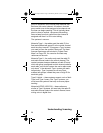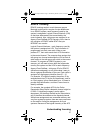
23
Understanding Scanning
Simplex Operation
Simplex systems use a single frequency for both
transmit and receive. Most radios using this type of
operation are limited to line-of-sight operation. This
type of radio is frequently used at construction job
sites, and with inexpensive consumer radios such as
GMRS/FRS radios. The range is typically 1-8 miles,
depending upon the terrain and many other factors.
Repeater Operation
Repeater systems use two frequencies: one transmits
from the radio to a central repeater; the other transmits
from the repeater to other radios in the system. With a
repeater-based system, the repeater is located on top
of a tall building or on a radio tower that provides great
visibility to the area of operation. When a user
transmits (on an input frequency), the signal is picked
up by the repeater and retransmitted (on an output
frequency). The user’s radios always listen for activity
on the output frequency and transmit on the input
frequency. Since the repeater is located very high,
there is a very large line of sight.
Typical repeater systems provide coverage out to
about a 25-mile radius from the repeater location.
What is Trunk Tracking?
Your BCD396T is designed to track the following types
of trunking systems.
• Motorola Astro (APCO 25) trunking systems.
• Motorola Type I, Type II, Type IIi hybrid,
SMARTNET, and PRIVACYPLUS analog trunking
systems, which are extensively used in 800 MHz
communication systems.
• LTR trunking systems
• EDACS SCAT trunking systems
• EDACS trunking systems
BCD396T Paper OM.fm Page 23 Wednesday, March 30, 2005 8:36 PM


















